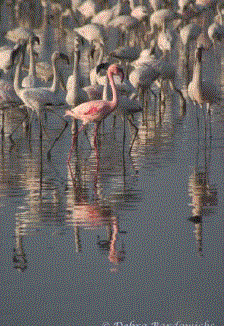
Preparing for Another Pink Death: Bird Care Insights
Share
Flexible, standardised post-mortem examinations important in preventing future flamingo die-offs

Not only is this a distressing sight to witness, it is also a serious concern for conservationists.
The Rift Valley lakes represent the largest of four populations of this species worldwide – consisting of around 1.5-2.5 million birds. Because only a handful of salt lakes support this huge population, these mysterious die-offs have the potential to threaten the global health of the species.
Suggested causes for the die-off range from infectious diseases such as avian tuberculosis and avian cholera, to poisoning by cyanobacterial toxins, insecticides or heavy metals. This variety of potential causes means that over the years studies have been undertaken by researchers from many different disciplines, each using different approaches.
The result has been samples that cannot easily be compared with each other, and no consensus on the underlying cause. There is a real need for the standardisation of sample-taking and examination if we are to understand the causes of mortality in these birds.

In a paper published this month in the journal "Ostrich" Professor John Cooper, Dr Amy Deacon and Dr Thomas Nyariki present tried and tested protocols for the postmortem examination of flamingos, so that we will be better prepared in the event of future die-offs. The strength of these easy-to-follow protocols lies in their flexibility, which allows them to be adjusted according to the available labour and number of dead birds.
When there are many birds and/or few staff, the ‘super-fast track’ form ensures that the most essential data and vital samples will be prioritised; when there are fewer birds and/or more people, instructions for a comprehensive examination can be followed.
Professor Cooper has confidence that the new protocols will prove vital to conservation efforts: “We believe that collecting standardised samples and measurements will be the key to finally finding the cause of these highly concerning events, and ultimately being able to prevent future die-offs and protect this globally important population.”
As well as being important primary consumers in the soda lake ecosystem, the promise of the once-in-a-lifetime experience of seeing these stunning pink birds in their millions draws large numbers of international tourists to the Rift Valley. With 15,000 visitors each year to Lake Bogoria alone, the long-term protection of this species is of great economic, as well as ecological, importance to the region.
The protocol forms are available as supplemental information alongside the article itself at:
http://www.tandfonline.com/doi/abs/10.2989/00306525.2014.901433#.U35iQ3awlm4
Author contacts:
Professor John Cooper: ngagi2@gmail.com
Dr Amy Deacon: aed32@st-andrews.ac.uk
Dr Thomas Nyariki: tom.nyariki@au-ibar
This study was carried out as part of a Darwin Initiative workshop and an Earthwatch Project under the direction of Dr David Harper. Text should be credited to Dr Deacon if reproduced in full. Photos are available from Dr Deacon on request and must be credited to Debra Bardowicks.
Written by Professor Cooper
